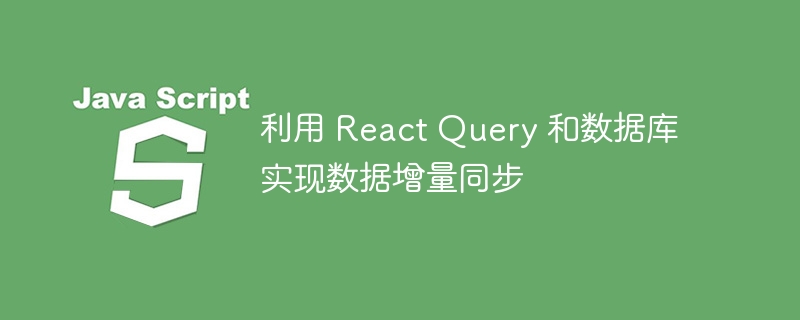Home >Web Front-end >JS Tutorial >Use React Query and database to achieve incremental data synchronization
Use React Query and database to achieve incremental data synchronization
- WBOYWBOYWBOYWBOYWBOYWBOYWBOYWBOYWBOYWBOYWBOYWBOYWBOriginal
- 2023-09-27 08:16:461003browse

Title: Incremental data synchronization using React Query and database
Introduction:
With the development of applications, the management of data becomes more and more important. In traditional applications, polling or long polling is usually used to achieve data synchronization. However, this method is not only inefficient, but also causes a waste of server resources. To solve this problem, we can use React Query and the database to achieve incremental data synchronization to improve application performance and user experience.
This article will introduce how to use React Query and the database to achieve incremental data synchronization, and provide specific code examples. First, we will explain the basic concepts and usage of React Query, and then introduce how to implement incremental data synchronization in React Query. Finally, we will demonstrate how to interact with the database to add, delete, modify and query data.
1. Basic concepts and usage of React Query
React Query is a modern state management library that focuses on processing requests and responses with the server. It provides a simple and powerful API that can help us manage data acquisition, synchronization and caching. The following are the basic concepts and usage of React Query:
- Query: Operation used to obtain data. It contains the query identifier, request function and other configuration information. By calling the useQuery hook function, we can define a Query in the component.
- Mutation: Operation used to modify data. Similar to Query, it contains identifiers, request functions, and other configuration information for modifying data. By calling the useMutation hook function, we can define a mutation in the component.
- QueryCache: Operation for caching data. It automatically manages caching and invalidation of data to improve application performance and responsiveness.
- QueryClient: Instances used to manage Query and Mutation. It can be obtained through the useQueryClient hook function.
2. Implementation of incremental data synchronization
Now we will introduce how to implement incremental synchronization of data in React Query. First, we need to define a Query and Mutation for obtaining and modifying data. The following is a specific example:
import { useQuery, useMutation } from 'react-query';
function fetchData() {
// 发起网络请求,获取数据
return fetch('/api/data')
.then(response => response.json())
.then(data => data);
}
function updateData(data) {
// 发起网络请求,修改数据
return fetch('/api/data', {
method: 'PUT',
body: JSON.stringify(data),
headers: {
'Content-Type': 'application/json'
}
})
.then(response => response.json())
.then(updatedData => updatedData);
}
function App() {
const { data } = useQuery('data', fetchData);
const mutation = useMutation(updateData);
const handleUpdate = newData => {
// 调用 mutation.mutate 函数,更新数据
mutation.mutate(newData);
};
return (
<div>
<button onClick={() => handleUpdate({})}>更新数据</button>
<pre class="brush:php;toolbar:false">{JSON.stringify(data, null, 2)}
In the above example, we use the useQuery hook function to define a Query named 'data' and obtain the data by calling the fetchData function. Then, we use the useMutation hook function to define a Mutation and modify the data by calling the updateData function. In the component, we trigger the update of the data by calling the mutation.mutate function.
3. Interact with the database
The fetchData and updateData functions in the above code examples are just simple network request examples. In actual applications, we usually need to interact with the database. The following is an example of adding, deleting, modifying, and querying operations with the database:
import { useQuery, useMutation, queryCache, useQueryClient } from 'react-query';
function fetchTodos() {
return axios.get('/api/todos')
.then(response => response.data);
}
function addTodo(newTodo) {
return axios.post('/api/todos', newTodo)
.then(response => response.data);
}
function updateTodo(id, updatedTodo) {
return axios.put(`/api/todos/${id}`, updatedTodo)
.then(response => response.data);
}
function deleteTodo(id) {
return axios.delete(`/api/todos/${id}`)
.then(response => response.data);
}
function TodoList() {
const { data: todos } = useQuery('todos', fetchTodos);
const queryClient = useQueryClient();
const mutation = useMutation(addTodo, {
onSuccess: () => {
queryClient.invalidateQueries('todos');
}
});
const handleAddTodo = newTodo => {
mutation.mutate(newTodo);
};
const handleUpdateTodo = (id, updatedTodo) => {
updateTodo(id, updatedTodo)
.then(() => queryClient.invalidateQueries('todos'));
};
const handleDeleteTodo = id => {
deleteTodo(id)
.then(() => queryClient.invalidateQueries('todos'));
};
return (
<div>
<form onSubmit={e => {
e.preventDefault();
handleAddTodo({
text: e.target.elements.text.value
});
e.target.reset();
}}>
<input type="text" name="text" placeholder="输入待办事项" />
<button type="submit">添加</button>
</form>
{todos && todos.map(todo => (
<div key={todo.id}>
<span>{todo.text}</span>
<button onClick={() => handleUpdateTodo(todo.id, { completed: !todo.completed })}>
{todo.completed ? '标为未完成' : '标为完成'}
</button>
<button onClick={() => handleDeleteTodo(todo.id)}>
删除
</button>
</div>
))}
</div>
);
}In the above code example, we use the axios library to send network requests to interact with the database. As you can see, we define a Mutation named addTodo through the useMutation hook function, which is used to add to-do items. After successful addition, queryClient.invalidateQueries('todos') is called to update the data. Similarly, we also define Mutation of updateTodo and deleteTodo to update and delete to-do items.
Summary:
This article introduces how to use React Query and the database to achieve incremental data synchronization. By using React Query's Query and Mutation, we can easily obtain, modify, add, and delete data. At the same time, we also demonstrated how to interact with the database and manipulate data through network requests. I hope this article will help you understand incremental data synchronization and make your applications more efficient and convenient.
The above is the detailed content of Use React Query and database to achieve incremental data synchronization. For more information, please follow other related articles on the PHP Chinese website!
Related articles
See more- How to import sql file into database
- React Query Database Plugin: Deep integration with container orchestration tools
- React Query database plug-in: practice of docking with data visualization tools
- How to implement database partitioning strategy in React Query?
- React Query Database Query: Frequently Asked Questions

